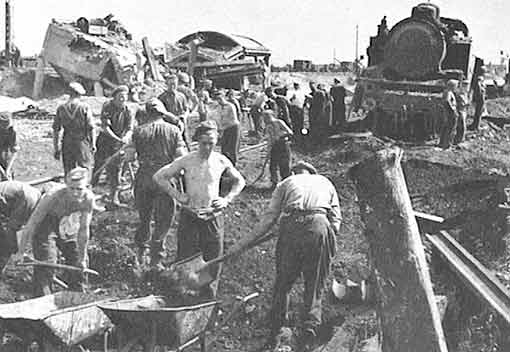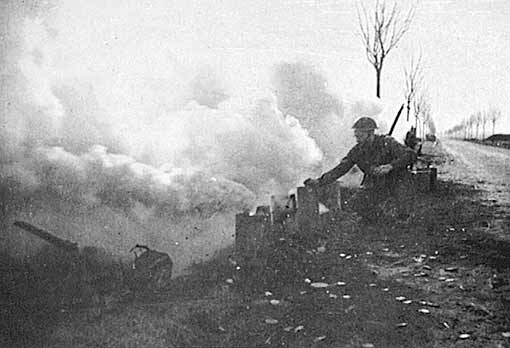|
The true glory of the war against Fascism
belonged to the ordinary soldier; to the Infantryman, the
mechanised Trooper, the Sapper, the Driver, the Pioneer. This
article is a brief review of the great part played by the
Pioneer in the campaign in North-West Europe. It would be
impossible, in an article of this size and scope, to allocate
the credit fairly; many important events will be omitted or
glossed over. It is hoped that these shortcomings will be
excused.
From the early hours of the Normandy
Beaches, through all the main engagements in France, the Lowlands
and Germany, up to the final assault over the Elbe, the Pioneer
was there. He was ready and eager to tackle any job. The range
of his activities was wider than the majority of other soldiers.
He was airborne to Arnhem, he was an important element in
the chemical warfare force whose task it was to obscure our
tactics from the enemy with smoke screens; with the Engineers
he built bridges, repaired railways, maintained roads; with
the Service Corps he brought up vital supplies and stores;
with the Ordnance Corps he helped to keep up the flow of guns
and ammunition; he could be found working in hospitals or
acting as stretcher bearer with front-line troops.
On D-day of the invasion of the Continent,
6 June 1944, 13 Pioneer companies landed with the first tide
and a further ten companies with the second tide, making a
total of about 6,700 men ashore by the end of the day. By
the end of D + 2, three Pioneer Group HQ and 42 companies
were ashore (about 12,000 men) and by D + 5, when Second Army
took over command from the Corps, the totals had increased
to 10 Pioneer Groups and 63 companies, representing approximately
19,000 men.
In addition to Major Rhodes-Wood’s account, the February 2004 newsletter of the Royal Pioneer Corps Association carried some extracts from the companies’ official war diaries...
“170 Company. June 6, 0825 hours. First serials landed on Nan sector, White and Red Beaches. Landing craft struck a mine on landing. Some opposition, particularly heavy sniping on Red. Some isolated pill boxes still holding out. These were eventually silenced by guns of landing craft.
“13.30 hours. Remainder of company, including OC, land on White Beach. Tasks: clearing Red, White and Green Beaches, laying lateral track and constructing wheeled and track exits.
“129 Company. June 6, 0800 hours. Disembarked on Red Beach under mortar fire. Water at commencement of day was only ankle deep but rose to 3ft 6ins. Moved to prearranged rendezvous. While going through a partially cleared minefield, two of our stretcher bearers brought in three wounded – commandos who had been lying in the open for four hours. Several enemy pockets were encountered and broken up by concentrated mortar fire. Working on beach and road clearance"
“293 Company. June 6, 0800 hours. Lay off beaches and at 12.30 landed and immediately commenced collecting casualties. Worked all night. Intermittent bombing but no casualties"
“June 7. Continued collecting casualties from beaches and inland, transporting them from BDS to FDS, and then loading them for evacuation. Loaded two landing ships with wounded. Bombed again during the night but no casulaties"
“June 8 and 9. Collecting casualties and evacuating them by sea, collected dead"
“June 10. HQ staff also evacuating casualties. Two killed and one wounded by enemy action"
“June 11. Evacuated 500 casualties. Quiet night, no bombing"
“Evacuation was one mad rush against the tides, but it was seldom that Father Neptune won the race, even during the spell of bad weather shortly after D-Day. On one occasion, a chain was formed to load the last 50 wounded by passing the stretchers from hand to hand overhead. The last man was put aboard as the water lapped the chins of those in the chain"
“73 Company. June 7. Landed wetshod at 1600 hours.
“June 9. Clearing Bernieres-sur-Mer of snipers and spies"
“June 10. Clearing Courcelles-sur-Mer of snipers and spies"
“June 11. Courcelles road repair and maintenance.”
The build-up of the force was rapid
and by D + 25, all the Pioneer units allotted to Second Army,
amounting to 14 Pioneer Group HQs and 115 Companies (33,500
men) were in Normandy. By D + 79, the complete Pioneer Order
of Battle consisting of over 68,000 officers and men, had
been brought to France. A force which was built up to 34 Group
Headquarters, 231 Companies and 23 Pioneer Civil Labour Units
(PCLUs).
As far is known, the first Pioneer
party landed 20 minutes after Operation Overlord had started,
their task being to assist in mine clearance and to dig a
Command Post in preparation for the arrival of the Beach Group
Commander. Other parties soon followed them and set to work
establishing beach exists, laying Sommerfield track and repairing
the roads from the shore ready for the tanks and Armoured
Fighting Vehicles to advance. Bridging equipment was unloaded
and assembled, road blocks demolished, beach store depots
built up.
The Pioneers who arrived with the assault
troops landed 'wetshod', which often meant a long wade ashore
in full equipment. Some had to swim ashore from grounded craft.
Pioneers working in the water laying flexible causeway off
the ramps of the landing craft, were engaged on particularly
hazardous work in rough seas. Many of the men came under heavy
artillery and small-arms fire in the early stages, but casualties
were surprisingly light. Parties took part in fighting operations
to clear strong points. The two most notable of many incidents
were the capture of 86 German Marines by a fighting patrol
of 120 Pioneer Company, and of one officer and 26 men by another
patrol of 225 Pioneer Company.
Pioneers performed many difficult and
dangerous tasks during the early days of the assault, for
which their varied training and wide experience proved invaluable.
A party of 53 Pioneer Company, for instance, formed a chain
and localised what might have been a serious conflagration,
when an aircraft crashed on a petrol dump and started a fire
which spread to an ammunition depot. Two of the party were
decorated with the George Medal for their part in this task
(you can read all about this event in the honours
and awards section).
After the initial assault on the beaches,
the highest priority was given to the task of establishing
airstrips for which 11 Pioneer Companies, forming part of
the five Airfield Construction Groups, were landed on D +
1 and D + 3. Most of the men were employed in laying track
on the runways and on operating technical equipment. Pioneers
were clearing the main line of communication through Caen
as soon as the town had been captured. All Pioneers landed
during the build-up were earmarked for special kinds of work.
Those that could not be linked up immediately with their employing
services were quickly absorbed on other tasks, mainly on road
construction, which represented a very real problem, or in
ammunition and petrol dumps.
At one time, there were about 20 companies
working in roads, and a small amount of civil labour, which
was enlisted, paid and controlled by Pioneer units specially
created for this task. The existing roads were completely
inadequate and too narrow to cope with the traffic of a modern
army; new roads and by-passes had to be constructed. The thick,
blinding dust and positive danger from constant streams of
passing traffic made this work very unpleasant and difficult.
When the weather deteriorated, causing a considerable reduction
in the quantity of stores that could be landed over the beaches,
all the available Pioneers were turned on to handling ammunition
and during the peak period, some 12 companies were employed
on this work.
No 36 Pioneer Company, previously trained
for the job, was allocated for work at Port-en-Bessin on the
laying of pipelines to Caen and Lisieux - pipelines which
were to feed the armies with petrol and which subsequently
were to continue right through Belgium, Holland and across
the Rhine. Three other Pioneer Companies were also employed
on similar work.
In the crossing of the River Orne,
Pioneers working with 8 Corps bridged the river and canal
and had the difficult task of helping to rebuild the road
through Colombelles after it had been pulverised by the Royal
Air Force. During the break out, they were called upon to
provide burial parties, for which they were given special
clothing, equipment and transport. Owing to the extensive
minefields, conditions were dangerous but the work was well
done. Casualties were suffered. A Pioneer Company, working
with 59 Division, was entrusted with the task of laying a
smoke screen across the River Orne, during which they lost
their Company Commander and three men killed.
At he same time, a Pioneer Group and
four companies were regularly employed on unloading ships
from Mulberry - the prefabricated port - and three Companies
were operating Dukws. Other Companies were erecting tentage
for Casualty Clearing Stations and General Hospitals or setting
up Bailey bridging; some were used in REME workshops repairing
landing craft and tanks, and on the responsible task of signposting
and traffic control. The men bivouaced in fields, in unusually
bad weather, working extremely long hours with little rest.
As the operation developed, the Pioneers
were called upon to undertake more and more varied jobs. The
arrival of administrative units was slowed down owing to a
lag in the shipping programme caused by the bad weather, but
in spite of this ten Pioneer Companies were called forward
urgently in mid-July to replace Infantry Battalions in Beach
Groups and more and more units continued to pour into the
Maintenance Area.

• Repairing the Caen-Cherbourg
Railway, August 1944
The Corps at its peak in May 1945 was
probably the largest Corps in the Army. It included 12,000
Officers, 166,000 British Personnel and 400,000 Commonwealth
Personnel. As well as being responsible for a civilian labour
force of 1,074,000 and a Prisoner of war force of 173,000.
Over 2,000 British personnel, serving with the Corps, and
nearly 6,000 other nationalities lost their lives during the
war. Many decorations for gallantry were gained by Officers
and men of the Corps. A list of these decorations follow.
The highest award received by a member of the Corps was the
George Cross, awarded to Cpl JP Scully on 8 July 1941. A copy
of the citation also follows in the honours and awards section.

• Laying a smoke-screen for
the Rhine crossing, March 1945
The Corps gained many awards for gallantry
and in addition received American, French, Dutch, Greek, Belgian
and Italian awards. Some 2,800 men of the Corps laid down
their lives oversees. On 26th November 1946, his majesty George
VI decreed that in recognition of its services the Corps should
have the distinction "Royal" added to the
title. In February 1950 the Royal Pioneer Corps became
part of the Regular Army. Since
the end of World War 2, Royal Pioneer Corps officers and soldiers
have played their part in all operations overseas. In the
long and glorious history of the British Army no other Corps
or Regiment has earned this single honour in so short a time.
|
